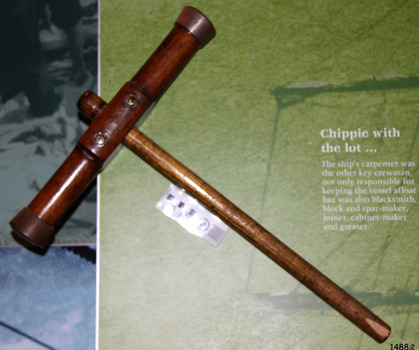Historical information
Caulking is the use of cork or other substances to seal the seams and joints of the vessel to make them watertight. Caulking lasts for quite some time but eventually dries out and needs to be replaced. A mallet or hammer is often used with a caulking iron to drive it along the seams. The caulking iron’s blade is tapered to be narrower at the tip to make it easier to remove it from the joint.
The shipwright’s tools on display in the Great Circle Gallery are connected to the maritime history of Victoria through their past owner, user and donor, Laurie Dilks. Laurie began his career as a shipwright in the mid-1900s, following in the wake of the skilled carpenters who have over many centuries used their craft to build and maintain marine vessels and their fittings. You can see Laurie’s inscription on the tool called a ‘bevel’.
Laurie worked for Ports and Harbours, Melbourne, for over 50 years, beginning in the early 1960s. He and a fellow shipwright inscribed their names on a wheelhouse they built in 1965; the inscription was discovered many decades later during a repair of the plumbing. Many decades later Laurie worked on the Yarra moving barges up and down the river and was fondly given the title ‘Riverboat Man’ His interest in maritime history led him to volunteer with the Maritime Trust of Australia’s project to restore and preserve the historic WWII 1942 Corvette, the minesweeper HMAS Castlemaine, which is a sister ship to the HMAS Warrnambool J202.
Laurie Dilks donated two handmade displays of some of his tools in the late 1970s to early-1980s. The varnished timber boards displayed the tools below together with brass plaques. During the upgrade of the Great Circle Gallery Laurie’s tools were transferred to the new display you see there today. He also donated tools to Queenscliffe Maritime Museum and Clunes Museum.
Significance
The shipwright’s tools on display in the Great Circle Gallery are connected to the maritime history of Victoria through their past owner, user and donor, Laurie Dilks. Laurie began his career as a shipwright at Ports and Harbours in Melbourne in the mid-1900s, following in the wake of the skilled carpenters who have over many centuries used their craft to build and maintain marine vessels and their fittings.
Physical description
Caulking mallet; a thick wooden handle with a round ‘T’ cross-bar near the end. Metal reinforcing is added around the ends of the head. Both sides of the wooden head are flared outwards towards the end. The head is reinforced where it intersects with the handle and around the ends of the head just above the tips. It once belonged to shipwright Laurie Dinks.
Subjects
- flagstaff hill,
- maritime museum,
- maritime village,
- warrnambool,
- shipwreck coast,
- great ocean road,
- shipwright,
- carpenter,
- shipbuilding,
- ship repairs,
- hand tool,
- equipment,
- caulking,
- ship maintenance,
- cooper,
- shipwright’s tools,
- shipwrights’ tools,
- tools,
- maritime trade,
- caulking mallet,
- caulking iron,
- laurie dilks,
- l dilks,
- port and harbours melbourne
References
- Merriam-Wester dictionary Definition of shipwrights’ tools
- The Historic Dockyard, Chatham Hand tools including Coopers, Carpenters, Shipwrights and Sailmakers
- Maritime Heritage Association of Vic. 2011 Yarra’s Riverboat Man - Laurie Dilks, shipwright
- Bay Fish n Trips Plover (Part 2) - The middle years, 2017, re L Dilks shipwright
- About the HMAS Castlemaine Volunteer Laurie Dilks




